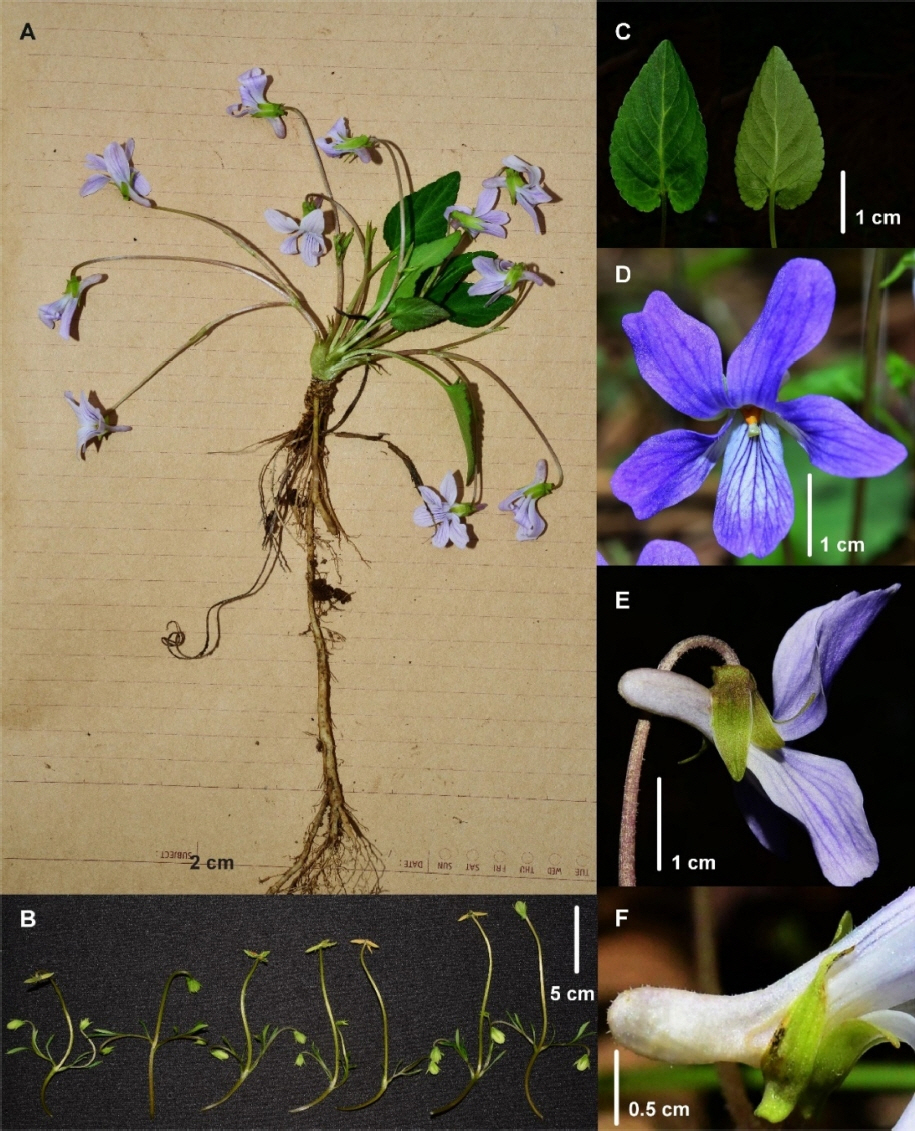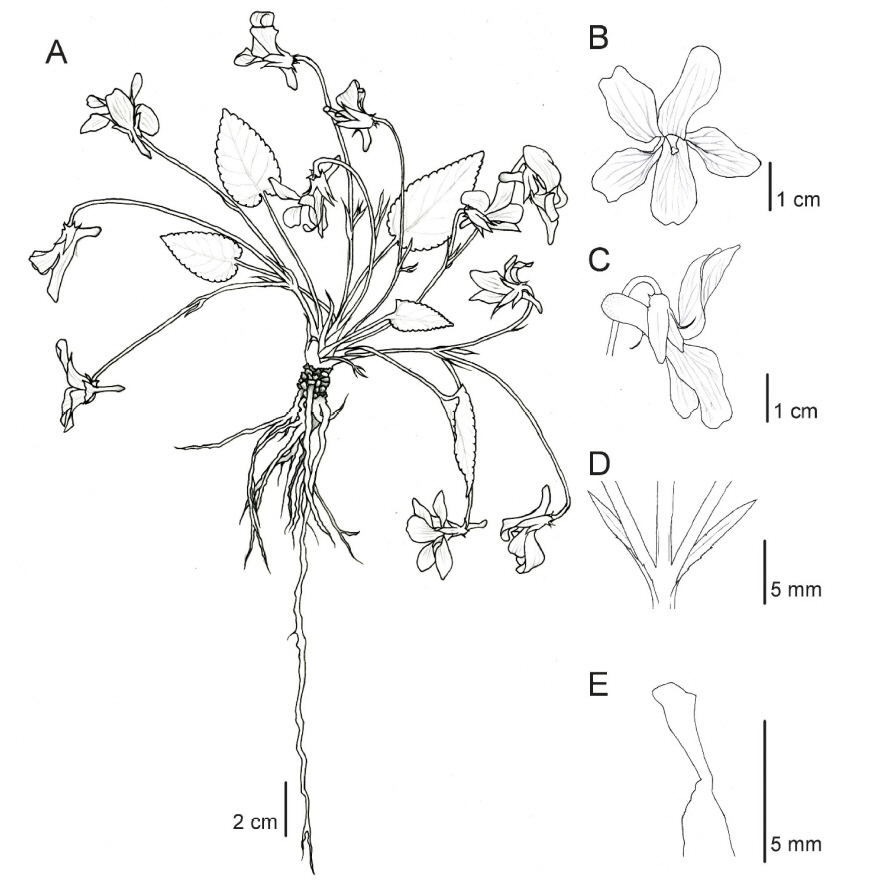/home/virtual/kjpt/journal//../xmls/kjpt-49-2-140.xml
제비꽃속(제비꽃과)의 신종: 가지제비꽃(Viola ramiflora K. O. Yoo)
적 요
제주도에서 제비꽃속의 신종인 가지제비꽃(Viola ramiflora K. O. Yoo)을 새로이 발견하여 기재 및 도 해하였다. 가지제비꽃은 꽃이 연한 자색이고 잎이 삼각상 난형, 난형 또는 장타원형으로 엽병에 얕은 날개가 발 달한다는 점에서 제비꽃계열의 털제비꽃, 서울제비꽃, 흰털제비꽃, 그리고 왜제비꽃과 비슷하나 폐쇄화와 개방화 의 화경이 뚜렷하게 분지하며, 폐쇄화의 포엽이 장란형으로 신장하는 특징을 가져 신종으로 명명하였다.
주요어: 제비꽃속, 가지제비꽃, 신종, 제주도
Abstract
A new taxon, Viola ramiflora K. O. Yoo (Violaceae), from Jeju-do is described and illustrated. V. ramiflora shares several characteristics (pale purple flowers; triangular-ovate, ovate, or oblong leaf blades; winged petioles) with the related species V. hirtipes, V. japonica, V. phalacrocarpa, and V. seoulensis. However, this new species has branched cleistogamous and chasmogamous peduncles and oblong-ovate cleistogamous bracteoles.
Keywords: Viola, Viola ramiflora, new species, Jeju-do
The family Violaceae Batsch is composed of approximately 25 genera, most of which are herbaceous or shrubs, with approximately 900 species distributed throughout the world. The genus Viola L. is the most evolved group in Violaceae ( Melchior, 1925; Hekking, 1988), with about 525–600 species distributed in the temperate northern hemisphere and tropical regions ( Melchior, 1925; Clausen, 1964; Ballard, 1996; Ballard et al., 1999). A study of the distribution of Korean Viola was initiated by Matsumura (1886), who described three species, including Viola japonica Langsd. ex Ging. It was also carried out by Palibin (1899), Nakai (1916), and Maekawa (1954), and it is now known that nearly 45 taxa are distributed in Korea ( Lee, 1996; Lee, 2003; Lee, 2006; Lee and Yoo, 2007; Jang et al., 2009; Lee et al., 2012; Lee et al., 2014). This study describes the morphological characteristics of Viola ramiflora K. O. Yoo, a new species of found in Jeju-do. The new species is similar to Viola hirtipes S. Moore, Viola japonica Langsd. ex Ging, Viola phalacrocarpa Maxim., and Viola seoulensis Nakai and of the series Chinensis in that the flowers are pale purple and the leaves are triangular-ovate, ovate, or oblong, and the petioles have narrow wings. However, this species is distinguished from other taxa by the branched cleistogamous and chasmogamous peduncles and oblong-ovate cleistogamous bracteoles. These morphological characters were continuously observed when these plants are cultivated in greenhouse over many years. The same characteristics were also observed in new individuals after seeding with seeds obtained from cleistogamous and chasmogamous samples ( Lee, 2014). Therefore, we named this new species Viola ramiflora.
Taxonomic Treatment
Viola ramiflora K. O. Yoo, sp. nov. ( Figs. 1, 2).– TYPE: Korea. Jeju-do: Jeju-si, Ora-dong, 250 m, 4 Apr 2013, K. O. Yoo et al. KWNU-95005 (holotype, KWNU; isotypes: KWNU).
Korean name: Ga-ji-je-bi-kkot 가지제비꽃.
Diagnosis: Viola ramiflora K. O. Yoo is distinguished from its related species Viola hirtipes, Viola japonica, Viola phalacrocarpa, and Viola seoulensis by having a peduncle form and bracteoles with a cleistogamous shape.
Herbs, perennial, acaulescent. Rhizome short. Roots white, elongated. Leaves basal, rosulate, pubescent; blade triangular-ovate, ovate, or oblong, 2.1–4.7 × 1.2–2.8 cm; petiole 3.2–10.8 cm long, narrow winged, pubescent. Flowers pale purple; peduncles 3-branched in the middle, pubescent, 6.6–13.0 cm long; bracteoles middle or above middle, oblong-ovate, 6.5–10.7 mm long, margins serrate or entire. Sepals lanceolate or ovate-lanceolate, 5.7–8.1 × 1.5–2.6 mm. Petals 5, glabrous; upper ones obovate, 1.2–2.3 cm, lateral ones oblong-obovate, 0.8–1.7 cm long, lower ones obovate, 1.3–2.4 cm long; spur tubular, 5.6–9.6 × 2.0–2.5 mm, glabrous or sparsely puberulent. Stamens 5; 2 anthers extend in-to spur, secrete nectar. Styles clavate; stigmas capitate, beaked in front. Capsule obovate, glabrous. Seeds brown, pale brown, ovoid-globose, 1.9–2.2 × 1.2–1.3 mm ( Table 1).
Flowering: April.
Distribution: Korea (Jeju-do).
Etymology: The specific epithet is derived from branched peduncle. The Korean name, Ga-ji-je-bi-kkot, comes from the morphological characters of the branched peduncle.
Habitats: Approximately 200 individuals of Viola ramiflora K. O. Yoo were found at the entrance and top of the Oreum in Jeju-do. This new species occurs under trees in forests dominated by Pinus thunbergii Parl., but the shading rate is high due to the low coverage. This species also occurs with other herbaceous species such as Stellaria media (L.) Vill., Corydalis incisa (Thunb.) Pers., Veronica persica Poir., Artemisia princeps Pamp., and Miscanthus sinensis var. purpurascens (Andersson) Rendle.
Additional specimens examined (paratypes): Korea. Jejudo: Min Oreum, 4 Apr 2014, KWNU-93601, 93602 (KWNU); 11 Apr 2014, KWNU-93567, 93600, 93603, 93604 (KWNU); 15 Apr 2017, KWNU-93704, 93705, 93718 (KWNU).
A Key to Viola ramiflora and its related taxa
1. Leaves ovate, ovate-ellipsoid, triangular-ovate, oblong, orbicular.
1. Leaves narrowly ovate, triangular-lanceolate, broadly triangular.
7. Flowers purple.
8. Petiole glabrous; lateral petals pubescent················ ··········································· V. mandshurica 제비꽃 8. Petiole pubescent; lateral petals glabrous················ ············································ V. yedoensis 호제비꽃
7. Flowers white.
9. Leaves narrowly triangular-lanceolate, petiole conspicuously winged from base; lateral petals with purple stripes ························ V. patrinii 흰제비꽃 9. Leaves broadly triangular-lanceolate, petiole narrowly winged on upper part; lateral petals, stripes absent ················· V. lactiflora 흰젖제비꽃
ACKNOWLEDGMENTS
We are deeply indebted to Yeon-Sun Yoon, Seungmi Kim, Hyunheui Kim, and Sunyeul Ko for the kindly provided information about type localities and for some of the photographs. We are also grateful to Yoojin Lee, who helped us to illustrate the manuscript. This study was supported by a 2017 Research Grant from Kangwon National University (No. 520170487), and this work was supported by the National Research Foundation of Korea (NRF) grant funded by the Korea government (MSIT) (No. 2019R1F1A1059552).
Fig. 1.
Photographs of Viola ramiflora K. O. Yoo. A. Adult plant with flowers. B. Cleistogamous. C. Adaxial-abaxial of leaf. D. Front view of flower. E. Side view of flower. F. Spur. 
Fig. 2.
Viola ramiflora K. O. Yoo. A. Adult plant with flowers. B. Front view of flower. C. Side view of flower. D. Bracteoles. E. Pistil. 
Table 1.
Comparison of morphological characters of Viola ramiflora K. O. Yoo and its related taxa.
|
Characters |
V. ramiflora
|
V. hirtipes
|
V. japonica
|
V. phalacrocarpa
|
V. seoulensis
|
|
Leaf length (cm) |
2.1 – 3.2 – 4.7 |
4.3 – 5.5 – 8.1 |
2.4 – 4.1 – 7.6 |
1.6 – 2.5 – 4.0 |
2.1 – 2.7 – 3.8 |
|
Leaf width (cm) |
1.2 – 1.8 – 2.8 |
2.0 – 2.9 – 4.5 |
1.6 – 2.6 – 4.8 |
1.1 – 1.8 – 2.7 |
0.8 – 1.1 – 1.6 |
|
Petiole length (cm) |
3.2 – 6.8 – 10.8 |
4.2 – 9.3 – 13.5 |
1.9 – 9.8 – 20.2 |
3.0 – 5.2 – 7.4 |
1.4 – 2.6 – 4.9 |
|
Petiole hairs |
Pubescent |
Pubescent |
Glabrous |
Pubescent |
Pubescent |
|
Flower color |
Pale purple |
Purple |
Pale purple, purple |
Pale purple, purple, dark purple |
Pale purple |
|
Peduncle branch |
3-branched |
Not branched |
Not branched |
Not branched |
Not branched |
|
Peduncle length (cm) |
6.6 – 10.3 – 13.0 |
5.0 – 10.6 – 14.8 |
5.5 – 13.1 – 19.8 |
6.7 – 8.7 – 12.3 |
4.3 – 6.2 – 7.7 |
|
Bract shape |
Oblong-ovate |
Lanceolate |
Lanceolate |
Lanceolate |
Lanceolate |
|
Bract length (mm) |
6.5 – 8.0 – 10.7 |
4.3 – 6.3 – 7.9 |
5.6 – 8.5 – 11.3 |
3.7 – 5.7 – 6.8 |
5.5 – 8.3 – 9.9 |
|
Bract tooth |
Serrate or entire |
Entire |
Entire |
Entire |
Entire |
|
Sepal length (mm) |
5.7 – 7.1 – 8.1 |
5.8 – 7.7 – 9.2 |
5.4 – 7.8 – 8.6 |
4.6 – 6.2 – 7.8 |
5.5 – 7.6 – 10.3 |
|
Sepal width (mm) |
1.5 – 2.0 – 2.6 |
1.7 – 2.3 – 3.2 |
1.6 – 2.2 – 2.8 |
1.5 – 1.7 – 2.0 |
1.9 – 2.4 – 3.1 |
|
Spur hairs |
Glabrous or sparsely puberulent |
Glabrous |
Glabrous |
Pubescent |
Glabrous |
|
Capsule hairs |
Glabrous |
Glabrous |
Glabrous |
Pubescent |
Glabrous |
|
Seed color |
Pale brown |
Pale brown |
Dark brown |
Dark brown |
Dark brown |
|
Seed length (mm) |
1.9 – 2.0 – 2.2 |
1.7 – 1.9 – 2.1 |
1.9 – 2.1 – 2.3 |
1.4 – 1.5 – 1.6 |
1.8 – 1.9 – 2.1 |
|
Seed width (mm) |
1.2 – 1.2 – 1.3 |
1.1 – 1.2 – 1.3 |
1.1 – 1.3 – 1.4 |
0.9 – 1.1 – 1.2 |
1.0 – 1.1 – 1.3 |
Literature Cited
Ballard, HE Jr. 1996. Phylogenetic relationships and infrageneric groups in Viola (Violaceae) based on morphology, chromosome number, natural hybridization and internal transcribed spacer (ITS) sequences. PhD dissertation. Univ of Wisconsin; Madison, WI, USA. 344.
Ballard, HE Jr. Sytsma, KJ and Kowal, RR. 1999. Shrinking the violets: phylogenetic relationships of infrageneric groups in Viola (Violaceae) based on internal transcribed spacer DNA sequences. Systematic Botany 23: 439-458.  Clausen, J. 1964. Cytotaxonomy and distributional ecology of western North American violets. Mandrono 17: 173-197.
Hekking, WHA. 1988. Violaceae Part I: Rinorea and Rinoreocarpus
. Flora Neotropica 46: 1-207.
Jang, SK. Lee, WT and Yoo, KO. 2009. New record of genus Viola: Viola grypoceras A. Gray var. pubescens Nakai in Korea. Korean Journal of Plant Taxonomy 39: 299-303 (in Korean).   Lee, H. 2014. Taxonomic studies on the Viola seoulensis Nakai and related taxa. Master’s thesis. Kangwon National University; Chuncheon, Korea. 60.
Lee, JS. Choi, CH. Han, KS. So, SK. Hwang, Y and Kim, MY. 2012. A new species of Viola (Violaceae): V. ulleungdoensis M. Kim & J. Lee. Korean Journal of Plant Taxonomy 42: 202-206.   Lee, JS. Hwang, Y and Kim, MY. 2014. A new species of Viola (Violaceae): V. breviflora J. Lee & M. Kim. Korean Journal of Plant Taxonomy 44: 84-87.   Lee, TB. 2003. Coloured Flora of Korea. Hyangmunsa, Seoul. 2096 (in Korean).
Lee, WT. 1996. Standard Illustrations of Korean Plants. Academy Publishing Co., Seoul. 624 (in Korean).
Lee, WT and Yoo, KO. 2007. Violaceae. In The Genera of Vascular Plants of Korea. Park, C-W (ed.), Academy Publishing Co, Seoul. 393-402.
Lee, YN. 2006. New Flora of Korea. Kyohaksa, Seoul. 1: 975. 2: 885 (in Korean).
Maekawa, F. 1954. Violaceae. In Enumeratio Spermatophytarum Japonicum III. Hara, H (ed.), Iwanami, Tokyo. 194-227.
Matsumura, J. 1886. Catalogue of plants in the herbarium of the College of Science. Imperial University, Tokyo. 287 pp.
Melchior, H. 1925. Die phylogenetische entwicklung der Violaceen und die natürlichen verwantschaftsverhältnisse ihrer gattungen. Repertorium Specierum Novarum Regni Vegetabilis 36: 83-125.
Nakai, T. 1916. Viola coreanae. The Botanical Magazine, Tokyo 30: 276-289.
Palibin, J. 1899. Conspectus Florae Koreae I. Acta Horti Petropolitani 17: 30-36.
|
|













